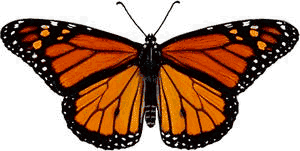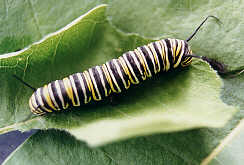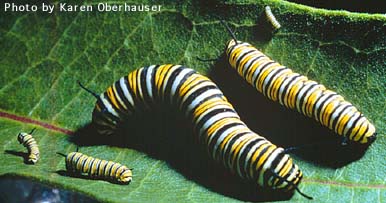|
HOME |
|

|
HOME |
|

The Monarch Butterfly is the king of the insect world. Even though they are small creatures, they do amazing things. First, they develop from tiny eggs, to a caterpillar, become a chrysalis, and finally transform into a beautiful butterfly.
Danaus plexippus is the scientific name for the Monarch Butterflies. Related species in the family are found on all continents except the polar regions, wherever milkweed and related plants are found. It also provides the Monarch with an interesting form of protection, since the milkweed juices eaten by the Monarch make it poisonous to birds. The beautiful orange color of the Monarch butterfly serves to teach predators that their intended meal might kill them.
EGGS
The female Monarch lays about 400 eggs on the underside of a separate leaves of milkweed plants. It takes the little yellow eggs about two weeks to develop. At the end of about two weeks, the eggs start to change colors from yellow to light gray. Eventually, the caterpillar's head is visible through its eggshell.
CATERPILLAR
 A
newborn caterpillar is only 2 millimeters long, but eats voraciously.
First it eats its own eggshell, then it starts feeding on milkweed.
For the first few days, it eats day and night, only stopping to rest
between meals. On the first day of life, it consumes its own weight
in food.
A
newborn caterpillar is only 2 millimeters long, but eats voraciously.
First it eats its own eggshell, then it starts feeding on milkweed.
For the first few days, it eats day and night, only stopping to rest
between meals. On the first day of life, it consumes its own weight
in food.
A full-grown caterpillar has ring-like sections called "spiracles". These are used by the caterpillar for respiration. It also has six legs, and five pairs of large prolegs, which are used to grip. Each end of the body of a caterpillar has one pair of fleshy filaments, their function is unknown. An adult caterpillar's size is about 5cm long with a weight of about 2,700 times more than when it hatched.
When the caterpillar is preparing to pupate, it becomes very restless. Some of them leave the milkweed plants that have been their homes since they were eggs. They look for a safe place to undergo their transformation.

Here you can see 5 stages of caterpillar growth.
When the caterpillar finds the right spot for its transformation, it uses a special gland in its mouth to weave a small silk button underneath a twig or leaf. It attaches its tail end to the lump. Then, it hangs upside down in the shape of a "J". Time passes. Finally, it begins moving, forcing the skin to split open. It wriggles for up to five hours to shed its skin for the fifth and last time. When the old skin is gone, it looks like a giant green water droplet. It has now entered the pupal stage.
CHRYSALIS
The butterfly now looks like a giant green droplet. It is slowly changing shape and colour. The outer layer hardens into an elegant emerald case, decorated with golden dots. This is known as "chrysalis," which is the Greek word for "golden." Inside this chrysalis, wonderful and unexplainable things are happening.
BUTTERFLY

After about two weeks, you are able to see a butterfly through the transparent chrysalis. When it emerges, the wings are wrinkled and wet, and the butterfly's abdomen is very large. The newly emerged butterfly clings to the casing of the chrysalis while fluids from its abdomen are pumped into the veins of the wings, expanding them. After a few hours when the wings are dry, and the abdomen reduces to a normal size, the butterfly flies away.
The one difference between a male monarch and a female monarch is the scent glands. The male's scent glands are marked by a spot of dark scales in the center of the hind wings, and females have broader black vein lines.
